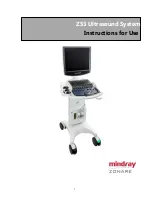
4.11 Additional functions
4-35
4.11.8
"
Freezing
"
/ analysis of graphs
The "freezing" of graphic curves is used for detailed analysis of the respiratory cycle and view-
ing via the encoder of instantaneous values of the curves. The function is active when the set
number of output graphs is from 1 to 3.
The activation function is performed via
icon on the main screen, at the same time:
•
graphic representation of the icon becomes active (dark blue);
•
current scale of the graph is saved;
•
the last recorded point of the curve is drawn at the end right position;
•
all previous points of the curve are drawn in proportion to the left;
•
vertical marker line appears on all charts, corresponding to the time of pressing the freeze
button;
•
line of instantaneous values of the curves corresponding to the position of the marker line
appears above graphs;
•
marker line is moved to the desired position by encoder;
•
at the repeated pressing the icon, "freezing" of the curves is canceled. Current cycle begins
to draw from the random moment.
Figure 4.8 – Pressed button “Freezing”
At rotating the encoder marker line moves to the left/right and accordingly to its position instan-
taneous values including time are changed. Moving the marker line can also be done by touch-
ing in the certain area of graphs. Time is counted down from the moment of pressing (eg. – 3.21
s).
4.11.9 Display brightness control
The function allows to change the display brightness separately for the day and night operation
mode with the icon
or
on the main screen of the device (Figure 4.4, position 9).
Night mode of the display is switched automatically from 24 pm to 5 am.
By clicking on the icon display mode is switched to the opposite (regardless of the time).
Brightness of the display can be adjusted through the [Menu]
→
[Service menu]
→
[Calibration]
→
[CIND]
→
[Day brightness] or [Night brightness]. The brightness of the day screen varies
Summary of Contents for MV200
Page 2: ......
Page 8: ......
Page 25: ...2 3 Front panel 2 9 2 3 Front panel Figure 2 1 Front view of the electronic unit ...
Page 124: ...4 21 Open valve function 4 76 For your notes ...
Page 158: ...6 11 Check and calibration of mainstream CO2 sensor 6 8 For your notes ...
Page 160: ...7 Troubleshooting 7 2 For your notes ...
Page 162: ...8 Transportation 9 Storage 10 Disposal 10 2 For your notes ...
Page 166: ...13 commission date mark 12 2 For your notes ...
Page 168: ...14 Maintenance and repair data 14 2 For your notes ...
Page 196: ...Appendix 2 9 Ideal body weight of the patient IBW App 2 10 For your notes ...
Page 200: ...Appendix 3 Electromagnetic environment App 3 4 For your notes ...
Page 201: ...Appendix 4 Pneumatic scheme of ventilator App 4 1 APPENDIX 4 PNEUMATIC SCHEME OF VENTILATOR ...
Page 202: ...Appendix 4 Pneumatic scheme of ventilator App 4 2 For your notes ...
















































